The Friends of the Wildflower Garden, Inc.
Plants of the Eloise Butler Wildflower Garden
The oldest public wildflower garden in the United States
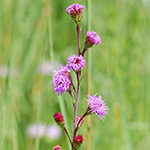
Common Name
Large-headed Blazing Star (Mountain Blazing Star, Northern Plains Gayfeather, Showy Blazing Star)
Scientific Name
Liatris ligulistylis (A. Nels) K. Schum.
Plant Family
Aster (Asteraceae)
Garden Location
Upland
Prime Season
Late Summer to Autumn
Blazing Stars (also called Gayfeathers) of the Liatris genus have general characteristics of: Stem leaves narrow and lance shaped; the flower heads, typically numbering 5 to 60 (but 160+ on a few species), appear on a spike, each flowerhead containing a number of small tubular 5-lobed pink-purple florets. Local variations in species populations will be observed. Rootstocks are corms and rhizomes.
L. ligulistylis can grow 3 to 4 feet tall on stems that can be sparsely to densely covered with fine hair. Stem color will vary from green to reddish.
Leaves are both basal and stem; the lower leaves up to 1 1/2 inches wide and 8 inches long, lanceolate in shape. Leaves reduce in length and become more linear up the stem with an abrupt change in the upper leaves to narrow and erect or ascending. Leaf surfaces can be sparsely to densely hairy and may be gland-dotted.
The floral array is a spike like raceme of 4 to 21 flower heads with the upper heads, which open first, usually larger than the others.
Flowers: The heads are packed with 30 to 70 tubular florets which have pinkish purple corollas with funnelform throats, without hair on the inside. The throat has 5 pointed lobes which spread when the floret opens. The 5 stamens surround the single style and are not exserted but the styles are much exserted when in flower. Styles have a bifuricated tip. Around the flower head are 4 to 5 series of phyllaries (floral bracts). These are oblong-obovate to spatulate is shape, unequal in size, with rounded to truncated tips. These are usually without hair but with purplish translucent margins. The middle phyllaries have wide irregularly cut edges. The flower heads are on noticeably long stalks.
Seed: Fertile flowers produce a dry seed (a cypsela), 5 to 7 mm long, that has bristly hair attached for wind dispersion. Seeds require 60 days of cold stratification for germination.
Habitat: This species of Liatris prefers full sun in well drained soil with moist to moderate moisture conditions. In the wild it will be found in meadows, ditches, along lakeshore ridges, etc. Long-tongued bees and butterflies will visit these plants. It grows from a sub-globose corm-like structure with densely fibrous roots. It will bloom in August if an early spring, otherwise early September.
Names: The genus Liatris is an old name whose meaning has been lost. The species ligulistylis, means 'tongue-like style' and refers to the style of the florets. As you can see above, a number of common names have been attached to this plant. The Garden uses a common name different from most references. USDA and the University of MN use Rocky Mountain Blazing Star, whereas The MN DNR calls it Northern Plains Blazing Star and Flora of North America calls it Northern Plains Gayfeather (all names as of 2019). This is why scientific names are important.
The author names for the plant classification are two-fold: First was ‘A. Nels.’ who is Aven Nelson (1859-1952) American botanist, author of numerous papers and the books Spring Flora of the Intermountain States and New Manual of the Botany of the Central Rocky Mountains. He originally published under the name Lacinaria ligulistylis in 1901 but his work was modified in 1903 to the current name by K. Schum.’ who is Karl Moritz Schumann (1851-1904) German botanist, curator of the Botanisches Museum in Berlin Dahlem. Several genera are named for him.
Comparisons: Several other species of blazing star have widely spaced heads in the floral array. Ontario Blazing Star, L. cylindracea, is also a short plant, but with smooth stems, smooth non-spreading phyllaries and 10 to 35 florets. Shaggy Blazing Star, L. pilosa, grows to 3-1/2 feet high with either smooth or finely hairy stems, fewer phyllaries and only 7 to 12 florets. Scaly Blazing Star, L. squarrosa, is a short plant, with hairy stems, phyllaries that are pointed and spreading to reflexed, and 23 to 45 florets. Northern Blazing star, Liatris scariosa, also has long flowerhead stalks, a large number of florets per head, but the stems do not have dense long hair but do have fine hair, the leaves have little or no hair, and the phyllaries all have rounded tips.
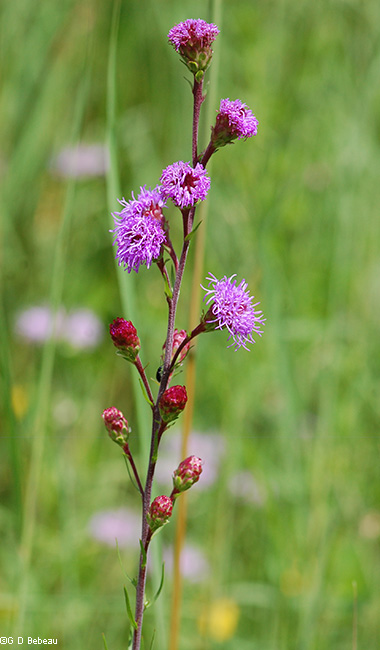
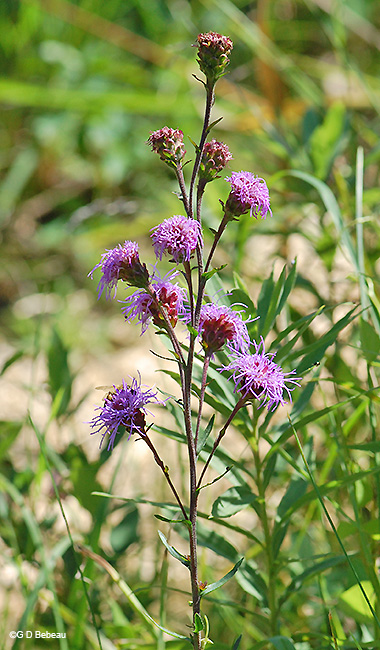
Above: The flowering spike has 4 to 21 stalked heads in an open array
Below: The flower head 30 to 70 florets with tongue-like styles, giving the species name - ligulistylis.
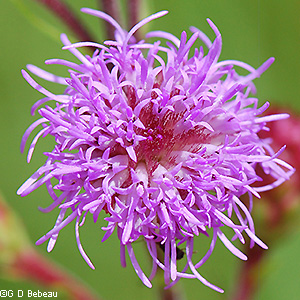
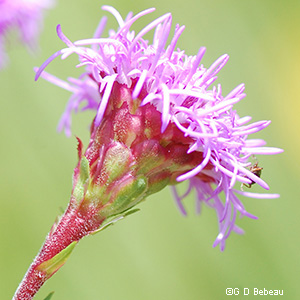
Below: 1st photo - The upper flower heads are larger than those below. 2nd photo - The phyllaries have rounded to truncated tips and the middle series may have translucent purplish margins as seen here. 3rd photo - Stems may be green to reddish and sparsely to densely hairy.
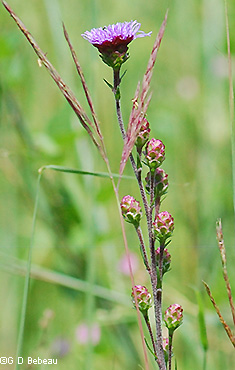
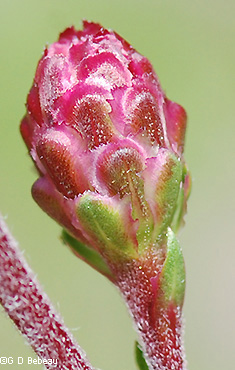
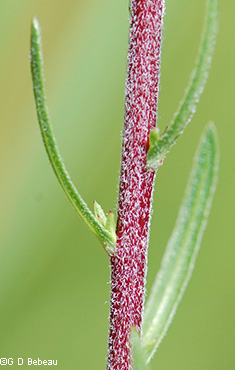
Below: The basal leaves are up to 1 1/2 inches wide and 8 inches long, lanceolate in shape. The surface can be hairy with gland dots as seen here above right.
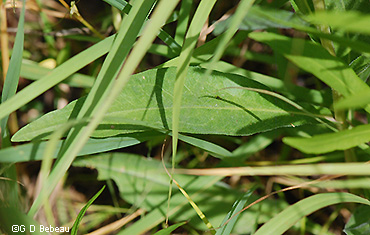
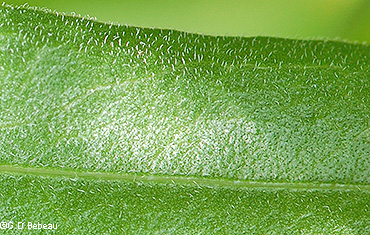
Below: Upper stem leaves are more linear with one central vein and can be densely hairy top side (1st photo) and underside (2nd photo).
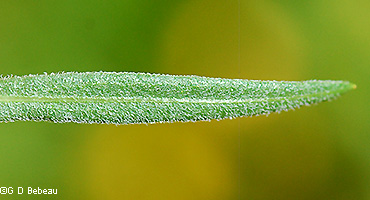
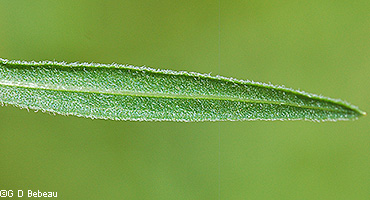
Notes: Liatris ligulistylis is not indigenous to the Garden area, it was planted later. It may very well be the species that Eloise Butler reported planting in 1908, and in many years thereafter, with plants obtained from her foraging area at what is now the Minnehaha Park area of Minneapolis. She reported collecting L. scariosa, Northern Blazing Star, which looks similar, but is not known in Minnesota. Martha Crone recorded this plant on her 1951 Garden Census. She too reported planting L. scariosa and her plants may well have been L. ligulistylis. The plant is found in the U.S. from Wisconsin westward to the Rocky Mountains - the northern plains, not south of Iowa and the Dakotas. It is found in most Minnesota counties except those in and near the Arrowhead.
In Minnesota five species of Liatris are considered native and several others have been reported but have never been collected. The native five are L. aspera, Rough Blazing Star; L. cylindracea, Ontario Blazing Star; L. ligulistylis, Large-headed (or Rocky Mountain) Blazing Star; L. punctata, Dotted Blazing Star; L. pycnostachya, Prairie Blazing Star.
Return to -- Site Plan/Archive Index --or-- List of Common Plant Names -- or -- List of Scientific Names -- or --Home Page - - - Back to top.
References: Plant characteristics are generally from sources 1A, 32, W2, W3, W7 & W8 plus others as specifically applied. Distribution principally from W1, W2 and 28C. Planting history generally from 1, 4 & 4a. Other sources by specific reference. See Reference List for details.
 Identification booklet for most of the flowering forbs and small flowering shrubs of the Eloise Butler Wildflower Garden. Details Here.
Identification booklet for most of the flowering forbs and small flowering shrubs of the Eloise Butler Wildflower Garden. Details Here.
©2015
Friends of the Wildflower Garden, Inc. Text and photos are by G. D. Bebeau unless otherwise credited. "www.friendsofeloisebutler.org"
120122